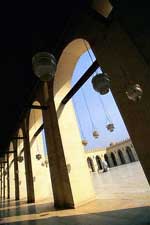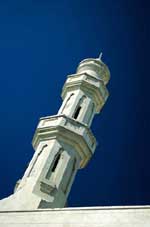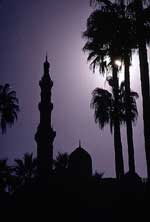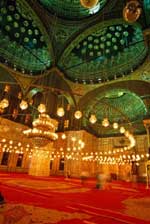|
Islam & Islamic Cairo
Islam was a new religion born of the wreckage of the Greco-Roman
world around the south of the Mediterranean. Its founder named
Mohammed from the wealthy city of Mecca (now in Saudi Arabia),
was chosen as God’s Prophet; in about 609 AD, he began to hear
divine messages, which were later transcribed into the Koran,
Islam’s holy book. This was the same God worshipped by Jews and
Christians.
 Thus when the Muslim troops of Amr conquered Egypt for Islam in
641 AD, they sited their city, Al-Fustat, just north of Coptic
Babylon. Here it grew into a powerhouse of religious conversion,
surpassing Alexandria as Egypt's leading city, though remaining
a mere provincial capital in the vast Islamic empire ruled from
Damascus by the khalifs, whose only direct contact occurred when
the last of the Umayyads (661-750) fled to Al-Fustst, and then
burned it. Their successors, the Abbasids (750-935) , ordered
the city to be rebuilt further north, and so Medinet al-Askar
came into being. More important in the long term was the Abbasid
reliance on Turkish-speaking warriors, who were granted fiefdoms
throughout the empire, including Egypt. Thus when the Muslim troops of Amr conquered Egypt for Islam in
641 AD, they sited their city, Al-Fustat, just north of Coptic
Babylon. Here it grew into a powerhouse of religious conversion,
surpassing Alexandria as Egypt's leading city, though remaining
a mere provincial capital in the vast Islamic empire ruled from
Damascus by the khalifs, whose only direct contact occurred when
the last of the Umayyads (661-750) fled to Al-Fustst, and then
burned it. Their successors, the Abbasids (750-935) , ordered
the city to be rebuilt further north, and so Medinet al-Askar
came into being. More important in the long term was the Abbasid
reliance on Turkish-speaking warriors, who were granted fiefdoms
throughout the empire, including Egypt.
In 870, encouraged by popular discontent, the Abbasids' viceroy
in Egypt asserted his independence, and went on to wrest Syria
from their control. Like his predecessors, Ahmed Ibn Tulun
founded a new city, reaching from Medinet al-Askar towards a
spur of the Muqattam. Inspired by the imperial capital of
Samarra, it consisted of a gigantic congregational mosque,
palace and hippodrome, surrounded by "the Wards" or military
quarters after which the city was named. However, when the
Abbasids invaded Egypt in 905, Al Qitai was razed and ploughed
under, sparing only the great Mosque of Ibn Tulun, which stands
to this day.
The city regained a shadow of its former importance under the
Ikhshidids (935-969) , who seceded from the later Abbasid
khalifs. But the impetus for its revival, and that of the
Islamic empire, came from Tunisia, where adherents of Shia Islam
had created their own theocracy, ruled by a descendant of Ali
and Fatima – the dynasty of Fatimids. Aiming to seize the
khalifate, they hit upon Egypt as an ill-defended yet
significant power base, and captured it with an army of 100,000
in 969. The Fatimid general, Gohar (Jewel), a converted Greek,
immediately began a new city where the dynasty henceforth
reigned (969-1171).
 By this time distinctions between the earlier cities had
blurred, as people lived wherever was feasible amidst the
decaying urban entity known as Masr (which also means "Egypt").
The Fatimids distanced themselves from Masr by building their
city of Al-Qahira (The Conqueror) further north than ever, where
certain key features remain. It was at the Al-Azhar Mosque that
Al-Muizz, Egypt's first Fatimid ruler, delivered a sermon before
vanishing into his palaces (which, alas, survive only in name);
while the Mosque of Al-Hakim commemorates the khalif who ordered
Masr's destruction after residents objected to proclamations of
his divinity. You can also see the great Northern Walls and the
Bab Zwayla gate, dating from Al-Gyushi's enlargement of Al-Qahira's
defenses. But as the Fatimid city expanded, Fustat began
disappearing as people scavenged building material from its
abandoned dwellings; a process that spread to Masr, creating
derelict quarters. By this time distinctions between the earlier cities had
blurred, as people lived wherever was feasible amidst the
decaying urban entity known as Masr (which also means "Egypt").
The Fatimids distanced themselves from Masr by building their
city of Al-Qahira (The Conqueror) further north than ever, where
certain key features remain. It was at the Al-Azhar Mosque that
Al-Muizz, Egypt's first Fatimid ruler, delivered a sermon before
vanishing into his palaces (which, alas, survive only in name);
while the Mosque of Al-Hakim commemorates the khalif who ordered
Masr's destruction after residents objected to proclamations of
his divinity. You can also see the great Northern Walls and the
Bab Zwayla gate, dating from Al-Gyushi's enlargement of Al-Qahira's
defenses. But as the Fatimid city expanded, Fustat began
disappearing as people scavenged building material from its
abandoned dwellings; a process that spread to Masr, creating
derelict quarters.
The disparate areas only assumed a kind of unity after Salah
al-Din (Saladin to the Crusaders) built the Citadel on a rocky
spur between Al-Qahira and Masr, and wallswhich linked up with
the aqueduct between the Nile and the Citadel so as to surround
the whole. Salah al-Din promoted Sunni, not Shia, Islam and
built madrassas to propagate orthodoxy; he ruled not as khalif,
but as a secular sultan (power) . His successors, the Ayyubids,
erected pepperpot-shaped minarets (only one remains, on Sultan
Ayyub's Madrassa and Mausoleum) and the magnificent tombs of the
Abbasid Khalifs and Imam al-Shafi'i (which still exist) in the
Southern Cemetery, but they made the same error as the Abbasids:
depending on foreign troops and bodyguards. When the Sultan died
heirless and his widow needed help to stay in power, these
troops, the Mamlukes, were poised to take control.
 The Mamlukes were a self-perpetuating caste of slave-warriors,
originally from Central Asia but later drawn from all over the
Near East and the Balkans. Their price in the slave markets
reflected the "value" of ethnic stock- 130-140 ducats for a
Tartar, 110-120 for a Circassian, 50-80 for a Slav or Albanian –
plus individual traits: sturdy, handsome youths were favored.
Often born of concubines and raised in barracks, Mamlukes
advanced through the ranks under amirs who sodomized and
lavished gifts upon their favorites . With the support of the
right amirs, the most ruthless Mamluke could aspire to being
sultan. Frequent changes of ruler were actually preferred, since
contenders had to spread around bribes, not least to arrange
assassinations. The Mamluke era is divided into periods named
after the garrisons of troops whence the sultans intrigued their
way to power: the Qipchak or Tartar Bahri Mamlukes (1250-1382) ,
originally stationed by the river (bahr in Arabic) ; and their
Circassian successors, the Burgi Mamlukes (1382-1517) ,
Quartered in a tower (burg) of the Citadel. The Mamlukes were a self-perpetuating caste of slave-warriors,
originally from Central Asia but later drawn from all over the
Near East and the Balkans. Their price in the slave markets
reflected the "value" of ethnic stock- 130-140 ducats for a
Tartar, 110-120 for a Circassian, 50-80 for a Slav or Albanian –
plus individual traits: sturdy, handsome youths were favored.
Often born of concubines and raised in barracks, Mamlukes
advanced through the ranks under amirs who sodomized and
lavished gifts upon their favorites . With the support of the
right amirs, the most ruthless Mamluke could aspire to being
sultan. Frequent changes of ruler were actually preferred, since
contenders had to spread around bribes, not least to arrange
assassinations. The Mamluke era is divided into periods named
after the garrisons of troops whence the sultans intrigued their
way to power: the Qipchak or Tartar Bahri Mamlukes (1250-1382) ,
originally stationed by the river (bahr in Arabic) ; and their
Circassian successors, the Burgi Mamlukes (1382-1517) ,
Quartered in a tower (burg) of the Citadel.
Paradoxically, the Mamlukes were also renowned as aesthetes,
commissioning mosques, mansions and sabil-kuttabs that are still
the glory of today's Islamic Cairo. They built throughout the
city, from the Northern to the Southern Cemetery, and the
Citadel to the Nile, and although urban life was interrupted by
their bloody conflicts, the city nevertheless maintained
civilized institutions: public hospitals, libraries and schools
bequeathed by wealthy Mamlukes and merchants. The caravanserais
overflowed with exotica from Africa and the spices of the East,
and with Baghdad laid waste by the Mongols, Cairo had no peer in
the Islamic world, its wonders inspiring many of the tales in
the Thousand and One Nights.
 But in 1517 the Ottoman Turks reduced Egypt from an independent
state to a vassal province in their empire, and the Mamlukes
from masters to mere overseers. When the French and British
extended the Napoleonic War to Egypt they found a city living on
bygone glories: introspective and archaic, its population
dwindling as civil disorder increased. Eighteenth-century
travelers like R.R Madden were struck by "the squalid
wretchedness of the Arabs, and the external splendour of the
Turks" , not to mention the lack of " one tolerable street" in a
city of some 350.000 inhabitants. But in 1517 the Ottoman Turks reduced Egypt from an independent
state to a vassal province in their empire, and the Mamlukes
from masters to mere overseers. When the French and British
extended the Napoleonic War to Egypt they found a city living on
bygone glories: introspective and archaic, its population
dwindling as civil disorder increased. Eighteenth-century
travelers like R.R Madden were struck by "the squalid
wretchedness of the Arabs, and the external splendour of the
Turks" , not to mention the lack of " one tolerable street" in a
city of some 350.000 inhabitants.
The city's renaissance – and the ultimate shift from Islamic to
modern Cairo – is owed to Mohammed Ali (1805-48) and his less
ruthless descendants. An Ottoman servant who turned against his
masters, Mohammed Ali effortlessly decapitated thevestiges of
Mamluke power, and raised a huge mosque and palaces upon the
Citadel. Foreigners were hired to advise on urban development
and Sharia Qalaa (Blvd Mohammed Ali) was ploughed through the
old city. As Bulaq, Ezbekiya and other hitherto swampy tracts
were developed into a modern, quasi-Western city, Islamic Cairo
ceased to be the cockpit of power and the magnet for
aspirations. But as visitors soon discover, its contrasts,
monuments and vitality remain as compelling as ever.
Popular Islamic Places : |